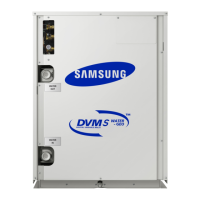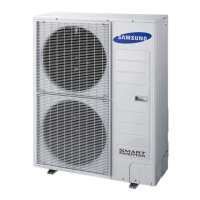88
Air tightness test and vacuum drying
Vacuum drying pipes and indoor units
Ƹϑʪϩͱͱϑ˙ͱθŵࣛߦߣߢϩͱΧθʪЭʪϩϩ˵ʪѤͱиͱ˙˙ͱθʪ˝ϑЇɵϑϩɇʀʪϑɇʒθʪϑϑϩɇ˝ɇϑϩϩ˵ʪϩʪθɇΧθʪϑϑЇθʪ
Use vacuum pump that allows vacuuming under -100.7kPa (5 Torr).
Ƹϑʪϩ˵ʪЭɇʀЇЇΧЇΧиϩ˵ϩ˵ʪʀ˵ʪʀЭɇЭʪϩͱΧθʪЭʪϩΧЇΧͱ˙θͱѤͱи˝ɵɇʀиɇθʒи˵ʪϩ˵ʪЭɇʀЇЇ
pump is stopped.
Completely close the liquid gas side service valve of the outdoor unit.
Charge additional refrigerant to the pipe
No
Yes
Perform vacuum drying again
Check for gas leakage
Vacuum destruction
࡛Apply nitrogen gas to the pipe at
ΧθʪϑϑЇθʪͱ˙ߢߢߧđΧɇ
YesNo
ĮЭʪθࣛߣߢߢߩťɇ࣑ߧƟͱθθ࣒
Pressure increase
Connect the manifold gauge to the liquid
side pipe and gas side pipe (when installing
outdoor units in module).
When installing outdoor units in module, connect the manifold
gauge to liquid side pipe and the gas side pipe.
Perform vacuum drying of the liquid side pipe
and gas side pipe (when installing outdoor
units in module) using a vacuum pump.
Make sure that check valve is installed to prevent pump oil from
Ѥͱи˝ϩͱϩ˵ʪΧΧʪ
While the vacuum gauge pressure is less than
ࣛߣߢߢߩťɇ࣑ߧƟͱθθ࣒ࡥΧʪθ˙ͱθϩ˵ʪЭɇʀЇЇʒθц˝
for more than 1 hour and close the valve.
Vacuum pressure must be checked with the vacuum gauge.
After vacuum pump stops, check whether
ϩ˵ʪΧθʪϑϑЇθʪϑɇϩɇʪʒиϩ˵ࣛߣߢߢߩťɇ
࣑ߧƟͱθθ࣒˙ͱθɇ˵ͱЇθ
࢜
If the pressure rises in an hour, either water is remaining inside the pipe or there is a leakage.
࢜
Ǯ˵ʪϩ˵ʪɇɵʪϩϩʪΧʪθɇϩЇθʪͱ˙ЭɇʀЇЇ˝ΧΧʪϑͱи࣑ʪϑϑϩ˵ɇߢঌA࣒ࡥͱϑϩЇθʪ˝˵ϩθʪɇиϩ˵
the pipe. Therefore, pay special attention to the pipe sealing in the winter.

